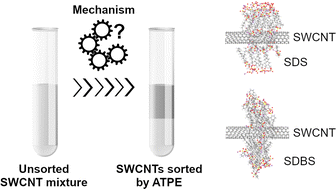Understanding the partitioning behavior of single-walled carbon nanotubes using an aqueous two-phase extraction system composed of non-ionic surfactants and polymers†
Abstract
In this work, a Pluronic/Dextran system was developed to discover the mechanism of the aqueous two-phase extraction (ATPE) technique, which is widely employed for the sorting of single-walled carbon nanotubes (SWCNTs) and other types of nanomaterials. The role of the phase-forming components and partitioning modulators was comprehensively investigated to gain greater insights into the differentiation process. The obtained results revealed that sodium dodecyl sulfate and sodium dodecylbenzene sulfonate operated as excellent partitioning modulators, enabling the diameter-based sorting of SWCNTs. Additionally, the data strongly suggested that different densities of various SWCNT species drove the movement of SWCNTs in the ATPE system. Consequently, the largest diameter SWCNTs were first influenced by surfactants and, thus, the nanotubes migrated towards a lower density top phase in the following order (7,5) > (8,3) > (6,5) > (6,4). Based on the in-depth analysis of the partitioning system, a mechanism was proposed that described the method in which the popular ATPE separation technique operates.

- This article is part of the themed collection: Nanoscale and Nanoscale Horizons: Carbon-based nanomaterials


 Please wait while we load your content...
Please wait while we load your content...